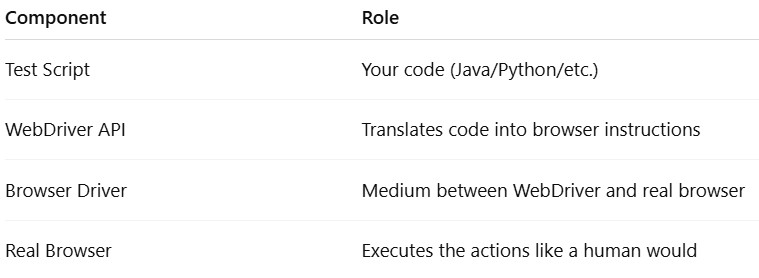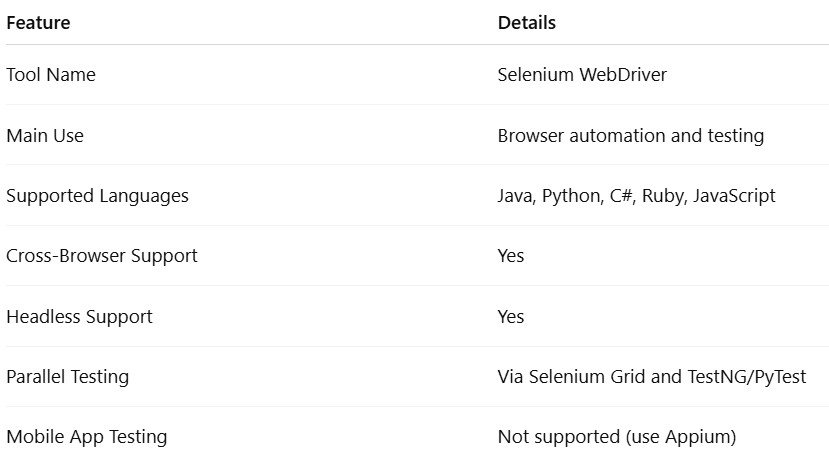 WEB TESTING
WEB TESTING Selenium WebDriver: My Ultimate Guide to Browser Automation Mastery

Automation is more than just writing scripts—it's about building confidence in your product.
I remember the first time I faced a regression nightmare. A tiny UI change ended up breaking a checkout flow and it went unnoticed until late-stage testing. That was my tipping point—I dove head-first into automation, and Selenium WebDriver became my go-to tool. Over time, I’ve used it to automate everything from login forms to massive end-to-end e-commerce journeys.
Today, I’ll walk you through what Selenium WebDriver is, how to set it up, best practices, real-world tips, and the common pitfalls I’ve learned to avoid—all from the lens of real, hands-on experience. 👇
🚀 What is Selenium WebDriver?
Selenium WebDriver is an open-source tool that lets you automate interactions with web browsers like Chrome, Firefox, Edge, and Safari.
What makes WebDriver shine is its code-centric approach. Unlike record-and-playback tools, it allows you to write test scripts in real programming languages—Java, Python, C#, Ruby, and more.
Here’s what Selenium WebDriver is not:
- It’s not just for QA testers—developers can (and should) use it too.
- It’s not a standalone app—you'll need an IDE and a test framework to make the most of it.
In short, it gives you full control over how you simulate a user’s behavior on a webpage—whether that’s logging in, clicking buttons, filling forms, or verifying content.
🔧 Key Features of Selenium WebDriver
Here are the features that make Selenium WebDriver an automation powerhouse:
🖥 Cross-Browser Support
Run your tests across Chrome, Firefox, Edge, and even headless browsers for CI/CD environments.
💻 Multi-Language Support
Pick your comfort language—Java, Python, C#, Ruby, JavaScript—they all work.
📦 Framework Integration
Combine WebDriver with tools like TestNG, JUnit, or PyTest for assertion handling, reports, and test structure.
⚡ Speed and Performance
No middleware or external server is needed like with Selenium RC. It's direct and faster.
📷 Real-Time Interactions
Click buttons, enter text, upload files, and even handle JavaScript pop-ups or alerts.
🌐 Parallel and Remote Execution
Use Selenium Grid to run your tests on multiple machines or across different browsers simultaneously.
🧠 Understanding the Selenium WebDriver Architecture
When I first started with Selenium, understanding its architecture felt a bit like decoding alien technology. But once I cracked it, everything else clicked into place.
Here’s the high-level flow:
- You write a test script in your language of choice.
- That script uses the WebDriver API to communicate with a browser-specific driver (like ChromeDriver).
- The driver, in turn, talks to the actual browser and executes the instructions.
📊 Visual Representation

Once I understood this chain, debugging became a whole lot easier.
⚙️ How to Set Up Selenium WebDriver (Quick Start Guide)
Getting Selenium WebDriver up and running is straightforward if you follow these steps:
🧰 Prerequisites:
- JDK installed (for Java users)
- An IDE like IntelliJ or Eclipse
- A browser (Chrome, Firefox)
- Browser driver (e.g., ChromeDriver)
💻 Java Setup Example:
javaCopyEditSystem.setProperty("webdriver.chrome.driver", "path/to/chromedriver");WebDriver driver = new ChromeDriver();driver.get("https://example.com");🐍 Python Setup Example:
pythonCopyEditfrom selenium import webdriverdriver = webdriver.Chrome(executable_path="path/to/chromedriver")driver.get("https://example.com")With just a few lines of code, you can launch a browser, open a page, and begin testing.
🧪 Writing Your First Selenium Test Case
Let’s automate a simple login form:
javaCopyEditWebDriver driver = new ChromeDriver();driver.get("https://example-login.com");WebElement username = driver.findElement(By.id("username"));WebElement password = driver.findElement(By.id("password"));WebElement loginBtn = driver.findElement(By.id("login"));username.sendKeys("myUser");password.sendKeys("myPass");loginBtn.click();🚀 Boom! You’ve just logged in using Selenium WebDriver.
🔍 Advanced Features You’ll Eventually Need
As your test suite grows, you’ll face more complex scenarios. Here are a few I had to master:
🕰 Handling Waits:
- Implicit Wait: Global delay for element searches.
- Explicit Wait: Waits for specific conditions like visibility.
- Fluent Wait: Custom polling strategy.
💥 Handling Alerts:
javaCopyEditAlert alert = driver.switchTo().alert();alert.accept();
🧾 Screenshots:
javaCopyEditFile screenshot = ((TakesScreenshot)driver).getScreenshotAs(OutputType.FILE);
🖱 Mouse & Keyboard Actions:
javaCopyEditActions actions = new Actions(driver);actions.moveToElement(element).click().build().perform();
These features helped me stabilize flaky tests and handle edge cases that most tutorials skip over.
🌐 Cross-Browser Testing with Selenium Grid
Nothing is worse than a test that passes on Chrome but fails on Firefox. That’s where Selenium Grid shines.
You can set up a Hub and multiple Nodes to run tests on different OS/browser combinations simultaneously.
💡 Pro Tip: Combine Selenium Grid with TestNG’s XML configuration for smooth parallel execution.
xmlCopyEdit<suite name="ParallelSuite" parallel="tests" thread-count="2"> <test name="ChromeTest"> <parameter name="browser" value="chrome"/> </test> <test name="FirefoxTest"> <parameter name="browser" value="firefox"/> </test></suite>
This setup helped me reduce regression testing time by over 60%.
🧱 Framework Integration That Matters
If you're serious about automation, you’ll want to use Selenium with a robust framework:

With CI tools like Jenkins, I automatically trigger tests on each push. Nothing feels better than catching a bug before QA even gets involved.
✅ Selenium WebDriver Best Practices I Swear By
Here’s a checklist I’ve refined over hundreds of test cases:
✅ Use Page Object Model (POM) for maintainability
✅ Use proper naming conventions for locators
✅ Keep tests independent and idempotent
✅ Avoid Thread.sleep()—always use waits
✅ Store test data externally (CSV, JSON, Excel)
✅ Clean up after every test (driver.quit())
Mistakes like hardcoding values or not using waits led me to hours of debugging. Trust me—following these practices will save you tons of time.
🧗 Common Selenium Challenges (And How I Beat Them)
🔄 Dynamic Elements
Solution: Use relative XPath, CSS selectors, or JavaScript execution.
🧨 Stale Element Reference
Solution: Re-fetch elements or use ExpectedConditions.
🧱 CAPTCHA or 2FA
Solution: Bypass for test environments or use mocks/stubs.
🕸 Flaky Tests
Solution: Stable locators, retries, and better synchronization strategies.
I used to dread failures due to environment hiccups. But once I refined my framework, my pass rate hit over 95%.
🚫 When Selenium WebDriver Isn’t Enough
As much as I love Selenium, it’s not always the best fit.
🚫 No native support for mobile apps
🚫 Can’t test desktop applications
🚫 Doesn’t offer visual or performance testing
🚫 No out-of-the-box reporting (though tools like Allure help)
For mobile testing, I use Appium. For performance? I switch to JMeter. Selenium has its limits—but within those limits, it excels.
🔮 The Future of Selenium WebDriver
Selenium 4 has brought a breath of fresh air:
🌟 Native support for W3C WebDriver
🌟 Improved handling of relative locators
🌟 Better debugging with Chrome DevTools Protocol (CDP)
More teams are shifting to automation-first testing strategies, and Selenium remains the cornerstone.
The way I see it, Selenium will continue evolving—possibly even blending with AI-based test generation tools. But for now, it’s still the king of browser automation.
🏁 Conclusion: Why I’ll Keep Using Selenium WebDriver
Selenium WebDriver has been a career-changing tool for me. From catching bugs early to scaling tests across platforms, it’s helped me deliver with confidence.
Here’s my advice:
Start small. Automate a single login flow. Understand how it interacts with the DOM. Build structure with POM. Then scale.
Master Selenium, and you'll master automated browser testing.
🙋♂️ SEO-Optimized FAQ: Selenium WebDriver
❓What is Selenium WebDriver used for?
Answer: Selenium WebDriver is used for automating web browser interactions like clicking buttons, filling forms, and navigating web pages to verify software functionality.
❓Is Selenium WebDriver free?
Answer: Yes, Selenium WebDriver is a free and open-source browser automation tool widely used for automated testing.
❓Which programming languages does Selenium WebDriver support?
Answer: It supports Java, Python, C#, Ruby, and JavaScript, giving teams flexibility based on their tech stack.
❓How does Selenium WebDriver differ from Selenium IDE?
Answer: Selenium WebDriver is code-based and more flexible, while Selenium IDE is a record-and-playback tool ideal for beginners and quick tests.
,
❓Can Selenium WebDriver test mobile apps?
Answer: No, Selenium WebDriver only automates browsers. Use Appium for mobile app automation.
❓What are common challenges in Selenium automation?
Answer: Handling dynamic elements, flaky tests, synchronization issues, and maintaining clean locator strategies are typical challenges.
📌 Summary Table

